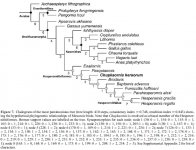Fred Ruhe
Well-known member

Tomonori Tanaka, Yoshitsugu Kobayashi, Ken'ichi Kurihara, Anthony R. Fiorillo & Manabu Kano, 2017
The oldest Asian hesperornithiform from the Upper Cretaceous of Japan, and the phylogenetic reassessment of Hesperornithiformes
Journal of Systematic Palaeontology. Online edition. doi:10.1080/14772019.2017.1341960
Abstract:
http://www.tandfonline.com/doi/full/10.1080/14772019.2017.1341960
Asian hesperornithiforms are extremely rare in contrast to the much more abundant record from North America. In Asia, these fossil birds are only known from fragmentary materials from Mongolia. Here we describe the skeletal remains of a new hesperornithiform Chupkaornis keraorum gen. et sp. nov. from the Upper Cretaceous Kashima Formation (Coniacian to Santonian) of the Yezo Group in Mikasa City, Hokkaido, Japan. This is the best-preserved hesperornithiform material from Asia and it is the first report of hesperornithiforms from the eastern margin of the Eurasian continent. Chupkaornis has a unique combination of characters: finger-like projected tibiofibular crest of femur, deep, emarginated lateral excavation with a sharply defined edge of the ventral margin of the thoracic vertebrae, and the heterocoelous articular surface of the thoracic vertebrae. Our new phylogenetic analysis revises the phylogenetic relationships of Hesperornithiformes. In contrast to previous studies, Enaliornis is assigned as the most basal taxon and Baptornis is positioned as more derived than Brodavis. Chupkaornis is a sister taxon to the clade of Brodavis and higher taxa. Parahesperornis and Hesperornis are positioned within Hesperornithidae, the derived Hesperornithiformes. Many of the skeletal character changes are concentrated at the base of Hesperornithidae (Parahesperornis and more derived taxa), and involve the modification of the pelvic girdle and hind limb morphology (e.g. dorsal directed antitrochanter of pelvis, short and sprawled femur, including probable lobe-toed feet suggested by the specialized distal articular surface of first digit of fourth toe, and predominantly robust digit IV phalanges). These skeletal modifications are likely adaptations for foot-propelled diving behaviour.
http://zoobank.org/urn:lsid:zoobank.org:pub:FB783237-E565-4B74-9386-EADF8E12DFD4
Keywords: Hesperornithiformes, diving birds, fossil birds, Late Cretaceous, new species
Enjoy,
Fred
The oldest Asian hesperornithiform from the Upper Cretaceous of Japan, and the phylogenetic reassessment of Hesperornithiformes
Journal of Systematic Palaeontology. Online edition. doi:10.1080/14772019.2017.1341960
Abstract:
http://www.tandfonline.com/doi/full/10.1080/14772019.2017.1341960
Asian hesperornithiforms are extremely rare in contrast to the much more abundant record from North America. In Asia, these fossil birds are only known from fragmentary materials from Mongolia. Here we describe the skeletal remains of a new hesperornithiform Chupkaornis keraorum gen. et sp. nov. from the Upper Cretaceous Kashima Formation (Coniacian to Santonian) of the Yezo Group in Mikasa City, Hokkaido, Japan. This is the best-preserved hesperornithiform material from Asia and it is the first report of hesperornithiforms from the eastern margin of the Eurasian continent. Chupkaornis has a unique combination of characters: finger-like projected tibiofibular crest of femur, deep, emarginated lateral excavation with a sharply defined edge of the ventral margin of the thoracic vertebrae, and the heterocoelous articular surface of the thoracic vertebrae. Our new phylogenetic analysis revises the phylogenetic relationships of Hesperornithiformes. In contrast to previous studies, Enaliornis is assigned as the most basal taxon and Baptornis is positioned as more derived than Brodavis. Chupkaornis is a sister taxon to the clade of Brodavis and higher taxa. Parahesperornis and Hesperornis are positioned within Hesperornithidae, the derived Hesperornithiformes. Many of the skeletal character changes are concentrated at the base of Hesperornithidae (Parahesperornis and more derived taxa), and involve the modification of the pelvic girdle and hind limb morphology (e.g. dorsal directed antitrochanter of pelvis, short and sprawled femur, including probable lobe-toed feet suggested by the specialized distal articular surface of first digit of fourth toe, and predominantly robust digit IV phalanges). These skeletal modifications are likely adaptations for foot-propelled diving behaviour.
http://zoobank.org/urn:lsid:zoobank.org:pub:FB783237-E565-4B74-9386-EADF8E12DFD4
Keywords: Hesperornithiformes, diving birds, fossil birds, Late Cretaceous, new species
Enjoy,
Fred




